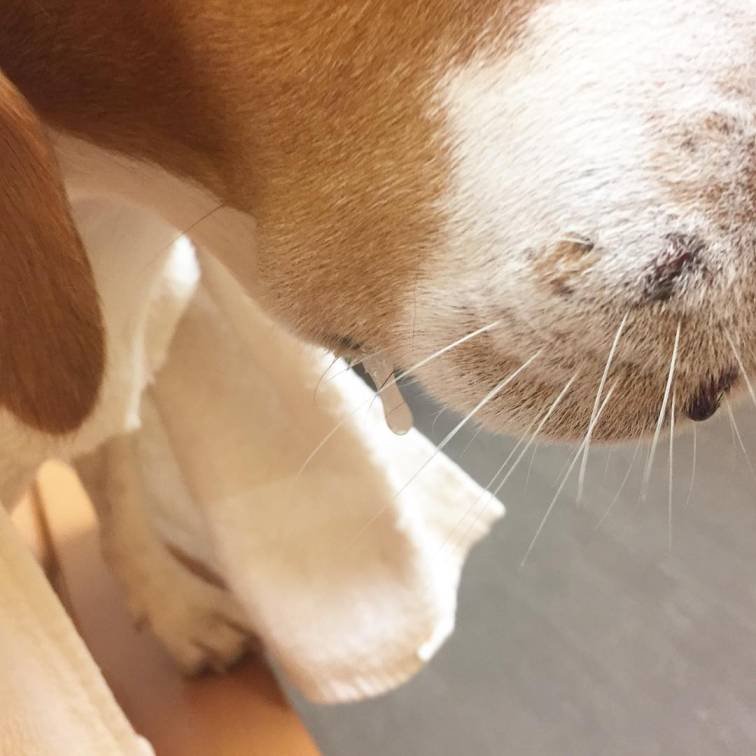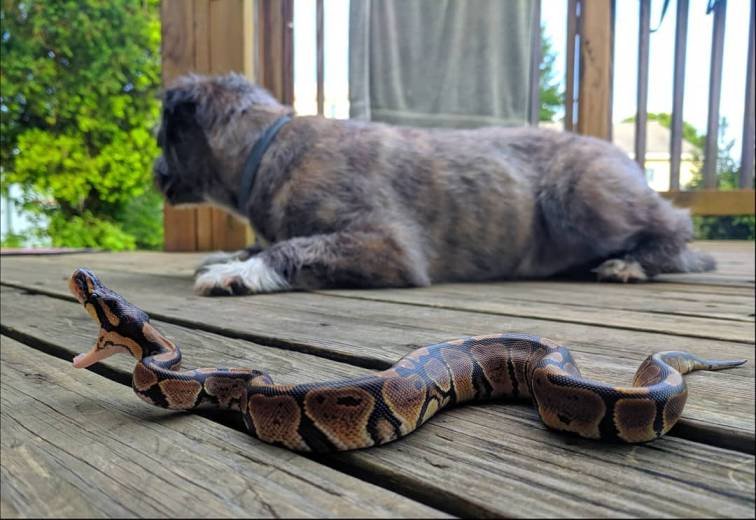Most people have a healthy respect for snakes. Our dogs might not share that and curiosity can get the better of them. First aid for snake bites on dogs can be required before you might expect it.
Snakes don’t bite or hurt for the sake of it. But if you or your dog stumbles upon one and surprise it, you are likely to get bitten. You must know that more than other emergencies, a dog with a snake bite should get first aid care immediately.
This article is your indispensable guide to dog first aid care for snake bites. We’ll tell you what to do to save your dog from the effects of a snake’s venom and how you can protect your pet from being bitten by this feared reptile. But first, let’s learn a few facts on why snakes bite and how you know that a snake has bitten your dog.
Why do Snakes Bite?
Snakes don’t bite just because they are snakes. On the contrary, snakes don’t need to bite other animals or humans for no reason. When snakes bite, it is because the snake is fighting for its food or feels threatened, so it bites to defend itself. Snake bites on dogs are almost always a matter of the snake feeling threatened.

As such, if your dog tries to seize a snake’s hard-hunted bird or rabbit or curiously pursues a snake incessantly, a bite reward could happen to your furry friend.
The severity of a snake bite on a dog will depend on factors such as:
- The type of snake (some snakes are more venomous, and others have a more painful bite).
- The amount of venom injected (a snake’s venom glands are more packed in warmer months and cause more harm).
- The number of bites (some snakes, such as the rattlesnake, can bite several times in a single instant).
- The location of the bite (a bite closer to the heart is more likely to kill your dog as the venom spreads faster through the body.
So, how will you tell that a snake has bitten your dog if you didn’t see the reptile? By knowing what a snake bite looks like and the symptoms that come with it.
What Does a Snake Bite Look Like on your Dog?
Unfortunately, snake bites are not readily visible on your dog’s skin and can be hard to spot. Besides, snake bite marks can be hidden beneath your dog’s fur, especially for dogs with longer hair.

What’s more, the razor-sharp snake fangs may only leave faint bite marks that can pass for a simple scratch. Also, if the bite spot does not have any swelling or redness, it may be close to impossible to notice it.
For all these reasons, a snake bite on your dog is primarily announced by other clinical signs and symptoms, which you can read about in the following section.
What are the Symptoms and Signs of Dog Snake Bites?
The signs and symptoms of snake bites can vary depending on the factors discussed earlier, such as the type of snake and the amount of venom injected into your dog.
Generally, though, you will notice some or all of these symptoms in a dog with a snake bite:
- Lethargy.
- Shaking or muscle tremors.
- Dilated pupils and reduced eye blinking.
- General weakness.
- Limping, if the bite is on the leg.
- Collapsing (dogs with snake bites often collapse and arise immediately, a sign that they have a dose of snake venom in their body).
- Paralysis.
- Urine and bowel incontinence.
- Atypical bleeding from the mouth, nose, or anus.
- Bloody or dark urine (Myoglobinuria / Haematuria).
- Diarrhea and vomiting.
Though it is unlikely to see a snake bite wound on your dog, you may notice a swollen area with tiny puncture wounds.
Where are Venomous Snakes a Threat for my Dog?
According to the National Institute for Occupational Safety and Health, there are four types of venomous snakes in the United States. The presence of each of these types varies with locations;
- Coral snakes are mostly found in sandy, wooded, and marshy areas of Southern US.
- Rattlesnakes are found across the US but are most common in mountains, beaches, deserts, and grasslands.
- Copperheads are common in the Eastern states, spreading far west until Texas.
- Water moccasins/cottonmouths are common in wetland areas, lakes, and rivers of the southeastern states.

As a dog owner, knowing where venomous snakes are most common is key in helping you know what type of danger to expect should your dog encounter a snake. The knowledge is also crucial in considering dog snake bite preventative measures, which we will discuss after telling you what you should do if a snake bites your dog.
What do I do if a Snake Bites my Dog?
Give immediate care to a dog bitten by a snake. Even when a snake is not venomous, the wound from the fangs can easily get infected and cause your dog other health complications.
It is advisable that you call a vet as soon as you realize that a snake has bitten your dog. The vet will tell you what to do and schedule a visit to attend to your dog. Soon after the call, offer first aid to your dog to reduce the effects of the venom.
Immediate first aid if a snake bites your dog
- If you can identify the snake bite spot, rinse the wound with clean water to neutralize the venom.
- Do not cover the bite wound with a bandage. Instead, use a pressure immobilization bandage above the bite spot, staying attentive not to restrict blood flow. Do not use a tourniquet.
- Ensure your dog stays in a position that keeps the bite wound below the heart. This will slow down the spread of the venom.
- Stay calm. Your dog will notice if you are anxious and get anxious as well. This can hasten the spread of the venom.
- Do not let your dog move around or walk to the car when you go to the vet. Movement facilitates blood flow and the spread of the venom to other parts of the body.
- Bring your dog to the vet clinic immediately to receive the snake antivenom.
Note that although you can give the snake antivenom to your dog, you should do so only with clear instructions from your vet. Also, this would mean that you have the antivenom in your dog first aid kit. Since snake antivenoms are costly and have a short shelf life, the best thing to do is bring your dog to the veterinarian to get the shot as soon as possible.
If your pet stops breathing, seek your vet’s advice on how to perform CPR on your dog.
As a general rule for dog snake bite care, you should drive your dog to the vet clinic and avoid losing time that could save your dog performing first aid care. This is especially recommended if the vet clinic is close by.
Snake venom can kill quickly or slowly, depending on the type of snake and the amount of venom. Let’s talk a bit more about how long a snake bite takes to kill your dog in the next section.
How Long Does it Take a Snake Bite to Kill a Dog?
Whether a dog dies from a snake bite and how long that takes depends on a number of factors:
- The type of snake (some snakes are venomous, others are not, and some are more poisonous than others).
- The amount of venom a snake ejects into your dog; the more the venom, the faster it can kill your dog.
- How much time has gone from the moment of the bite to the time the antivenom shot is administered.
- Your dog’s unique response to the effect of the venom. Most dogs with a snake bite die from paralysis of the respiratory muscles, which can take between an hour to 24 hours.
- The location of the snake bite; bites closer to the heart tend to kill faster.

The primary remedy for saving a dog bitten by a snake is to give first aid immediately and drive your dog to the vet for the antivenom shot ASAP. Around 80 % of pets who receive immediate first aid care survive snake bites.
How Do I Protect my Dog from Snake Bites?
The saying that prevention is better than cure is true when it comes to dogs and snake bites. Since most dog snakebites happen because dogs are curious around snakes or are in the way of snakes where they shouldn’t be, taking the following precautions can protect your dog from snake bites:
- Keep your compound clean by clearing the lawn and cutting any long grass. Snakes are hidden by long grass and can find a home or frequent your yard if unkempt. Besides, a backyard with long grass or areas that can serve as hiding places for rodents, rabbits, or wild fowls can attract snakes since these serve as food for the reptiles.
- Keep your track during your daily walks with your dog and have your dog on a leash. Long grass and bushes along a trail in the woods are often the hiding place for snakes, and your dog can accidentally stumble on one.
- Send your dog to a snake aversion training class so he can be taught how to recognize snake sounds, scents, and appearance.
- Have your dog take a snake bite vaccine such as Crotalus Atrox Toxoid. The vaccine provides protection and reduces the effect of snake venom on your dog before you get the pet to the vet. Note that the vaccine does not cancel the need for first aid and immediate vet care. However, it can be a lifesaver, especially for dogs most exposed to snake bites.
Final Thoughts
Snakes are harmless as long as you or your dog does not disturb them or stumble on them. However, if a snake feels threatened by the presence or activity of your dog, it can easily bite for defense.
If your dog gets bitten by a venomous snake, the risk of death is real. Nonetheless, this risk can be lessened with immediate first aid care.
So, if you notice dog snake bite signs and symptoms such as limping, lethargy, vomiting, collapsing, dilated pupils, or paralysis, look for a possible snake bite spot on your dog’s body to confirm the guess. Next, perform first aid by ensuring your dog stays calm, that the snake bite is always below the heart, and that the dog does not move to prevent the venom from spreading quickly.
Above all, save your dog by having a vet see him immediately to give the snake antivenom shot.
